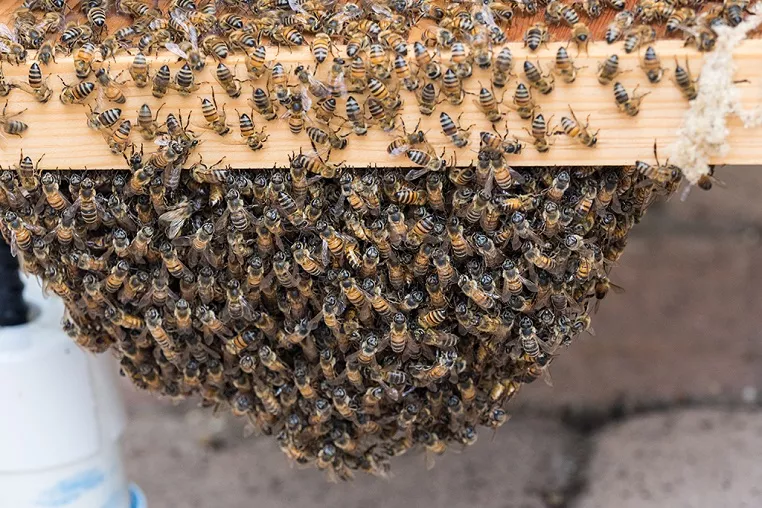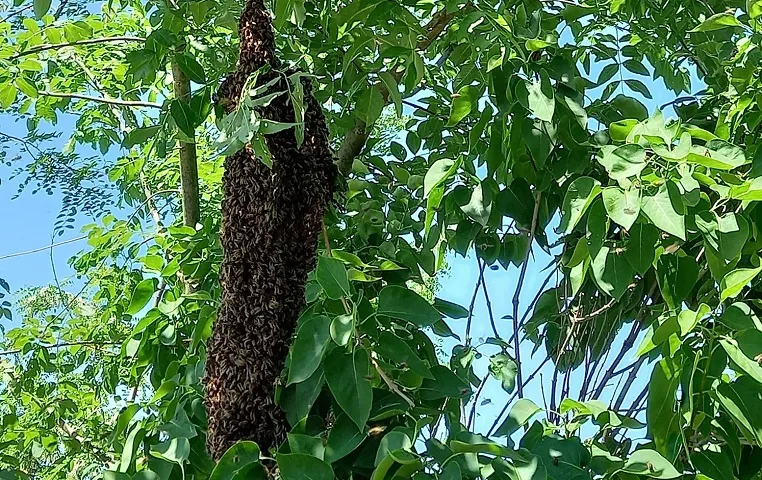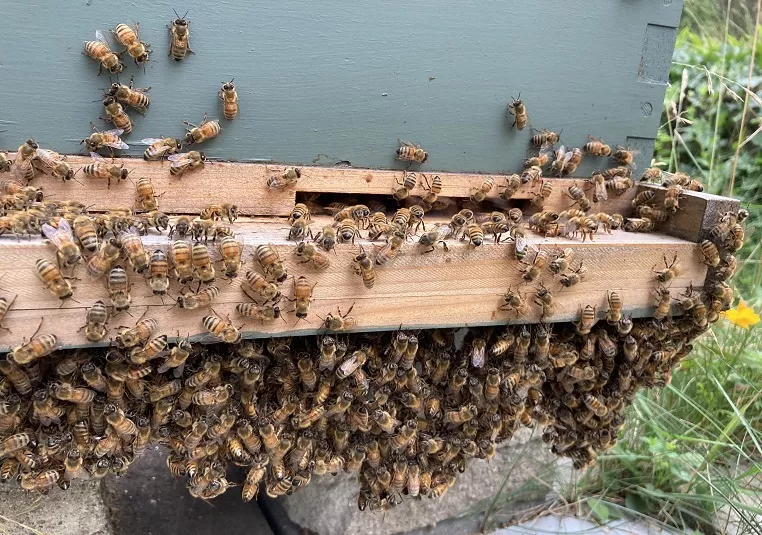I believe that all beekeepers have encountered this phenomenon and asked why bees form beards on the hives.
Bees have very different habits that even I didn’t understand when I started beekeeping. They have an amazing ability to move and act collectively, and beards are one such example. It’s always best to identify what the bees are doing and why. This way, you can avoid unnecessary worries about what’s going on and know when to take action and when to let the bees take care of themselves.

What Is Bearding Bees?
Beard formation is the term used to describe how bees gather in the front of the hive in a beard-like shape. They do this when they are hot and need to cool down. Beards help regulate the internal temperature of the hive, and bees flap their wings to increase airflow into the hive. This is completely normal behavior for your bees and nothing to worry about in itself. However, as a beekeeper, it’s best to be vigilant and watch your hives to make sure they have adequate space and ventilation.
Sometimes new beekeepers see their bees in beards and conclude that they are about to swarm. It’s important to know the difference between beard growth and swarming, and when they show signs of swarming. It’s also important to consider what you can do to ensure your bees are always comfortable in the hive.
What’s The Difference Between Beard And Swarming?
There are many signs that your bees have beards.
- Bees stand in the same direction as the hive entrance and flap their wings in an attempt to reduce the temperature of the hive
- Swarms of bees gather in front of the hive, apparently to make room in the hive
- Bearded bees usually crawl out of the hive without flying into the air
- Bees are calm and grouped
- It was a very hot day. When the evening heat subsides, your bees should return to the hive
- Beard growth can occur at any time, but is most common in the evening and early evening
In contrast, swarming has the following special features:
- The swarming bees roar loudly and appear active
- The swarming bees can cover the entire hive, but there is also increased air activity, and they often form clouds in the air around the hive
- Swarms usually appear in mid to late spring
- Swarms generally occur in the morning to the afternoon

Why Are There Beards?
Generally speaking, there are three causes of beards: heat, blockage and lack of ventilation within the hive. When bees grow beards, they do this to make room in the hive for extra ventilation on hot, humid days. The temperature and humidity inside the hive are maintained at a very precise percentage. Brooding requires temperatures of 32-36°C/90-97°F to form properly, and nectar needs the right amount of moisture to evaporate into honey.
On hot days when nectar is flowing, bees are always busy. They came and went at an incredible rate, with all colony members giving their all to their harvest. However, beards may form due to lack of nectar. Since there is no need to collect nectar, and it is hot inside the hive, bees are more likely to congregate in the beards outside.
Remember that beard growth is usually a very healthy sign that a strong group is at its peak. This could be a sign of a fertile colony with a large population, all working towards the goal of building a home for themselves! As you know each bee colony has different characteristics, so is each hive and exhibits a different amount of beard activity.
When Is The Beard Usually Done?
The formation of a beard is usually done during the hottest months or especially hot days of the year. In addition to being caused by the summer heat, the hive population may have grown to a considerable size, and it may become overcrowded due to the large flow of nectar. Crazy bee activity by many bees creates a lot of heat in the hive! These different factors cause bees to abandon their nests and congregate outside the hive in an attempt to stay cool. Essentially, they want to keep the hive from overheating and killing the immature bees.
What Can Beekeepers Do To Prevent Beards?
If your bees have beards and you know your hive is in good condition, don’t open the beards, and don’t worry if the bees decide to stay outside for a few days. Finally, bearded bees can take care of themselves.
However, if you’re not sure whether a beehive provides the ideal environment for your bees, there are several ways to improve the situation. If your bees have beards, make sure the hive is well ventilated and has a water source nearby. On a hot day, a strong, healthy colony uses more than a liter of water to cool the hive and prevent overheating.
Make sure you have adequate air circulation around your hives during late spring and summer months when temperatures are rising. Beehives are best for providing some shade from midday sun, especially in the late afternoon.
Bees were observed to perform better and be more productive away from direct sunlight, which is especially important in hot climates. A hive exposed to direct sunlight is much more difficult than keeping the inside of the hive cool in the shade. To alleviate this, you can set up a visor to cover the hives.
You may want to increase the entry area of the hives and make sure you have enough bars/super bars for them. Bees need to feel like they have more room to build. Watch your bees closely to see if adding extra Supers is beneficial. This gives the bees more space to disperse and can ease congestion in the hive.

Other Ways To Keep Bees Cool
Another option is to provide a top hive entry to improve ventilation. The top entry may consist of a wood frame with a landing board similar to a screened floor but without an actual grill. While bees continue to primarily use the lower entrance, they also fly in through another opening, and overall air circulation is improved.
Some beekeepers choose to provide additional ventilation in particularly hot locations by drilling small holes in the box handles. You can also help prevent overheating by painting your hives white or another light color. White reflects the sun’s heat in summer, keeping the hive cool, while dark colors absorb more heat and won’t help your colony stay cooler.
Will The Bees Freeze In The Winter?
Bees are masters of temperature control. Not only do they have a variety of ways to escape the heat in the summer, but they also have a variety of tricks to keep them warm in the winter and ensure their offspring survive. The body of each bee acts like a small heater, generating heat and energy while performing daily activities. Regardless of the season, it’s important to keep the nest at the right temperature so healthy bees will eventually hatch. Just as too hot is bad news, too cold is not good news.
In winter, they can press their breasts against the closed brood cells, sharing their body temperature with them. Bee workers gather around the queen to keep her warm. They keep their heads turned inward, and the bees within the cluster can feed on the stored honey.
The outer layers of worker bees isolate their sisters from the bee range. When workers on the outer edge of the cluster feel cold, they squeeze into the middle of the crowd. Then it’s the turn of the other bees to protect the colony from the winter cold. As temperatures drop, the outer workers contract, and the cluster continues to contract to ensure that precious heat doesn’t escape.
They also have an ingenious way of shaking, just like humans do when they have a cold. Bees vibrate their flight muscles but keep their wings still, which further increases their body temperature. Thousands of bees shivered in the hive, and the temperature in the center of the colony increased to the level needed to keep the colony healthy and growing.
